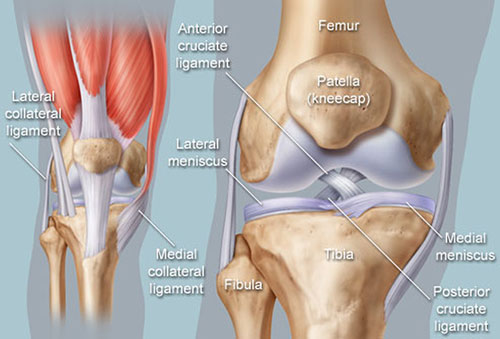
The knee is one of the largest and most complex joints in the body. The knee joint joins the thigh bone (femur) to the shin bone (tibia). The smaller bone that runs alongside the tibia (fibula) and the kneecap (patella) are the other bones that make the knee joint.
The end of these long bones normally have a smooth coating of the cartilage (articular cartilage) which is responsible for smooth gliding movement of the knee joint.
Tendons connect the knee bones to the leg muscles that move the knee joint. Ligaments join the knee bones and provide stability to the knee:
- The anterior cruciate ligament prevents the femur from sliding backward on the tibia (or the tibia sliding forward on the femur).
- The posterior cruciate ligament prevents the femur from sliding forward on the tibia (or the tibia from sliding backward on the femur).
- The medial and lateral collateral ligaments prevent the femur from sliding side to side.
All these 4 ligaments are necessary for normal function of the Knee joint. The Anterior and Posterior Cruciate ligaments generally work in unison.
Two C-shaped pieces of cartilage called the medial and lateral menisci act as shock absorbers between the femur and tibia.
The knee joint’s main function is to bend, straighten, and bear the weight of the body, along with the ankles and hips. The knee, more than just a simple hinged joint, however, also twists and rotates. In order to perform all of these actions and to support the entire body while doing so, the knee relies on a number of structures mentioned above. The human Knee joint performs one of the most complex movements across all three axes. They are bending, side ways moving and rotations. In our day to day life we use all the three movements in varying degrees to perform activities like walking , jogging, climbing up and down stairs, sitting on & getting up from chair, commode, getting in and out of car etc…
